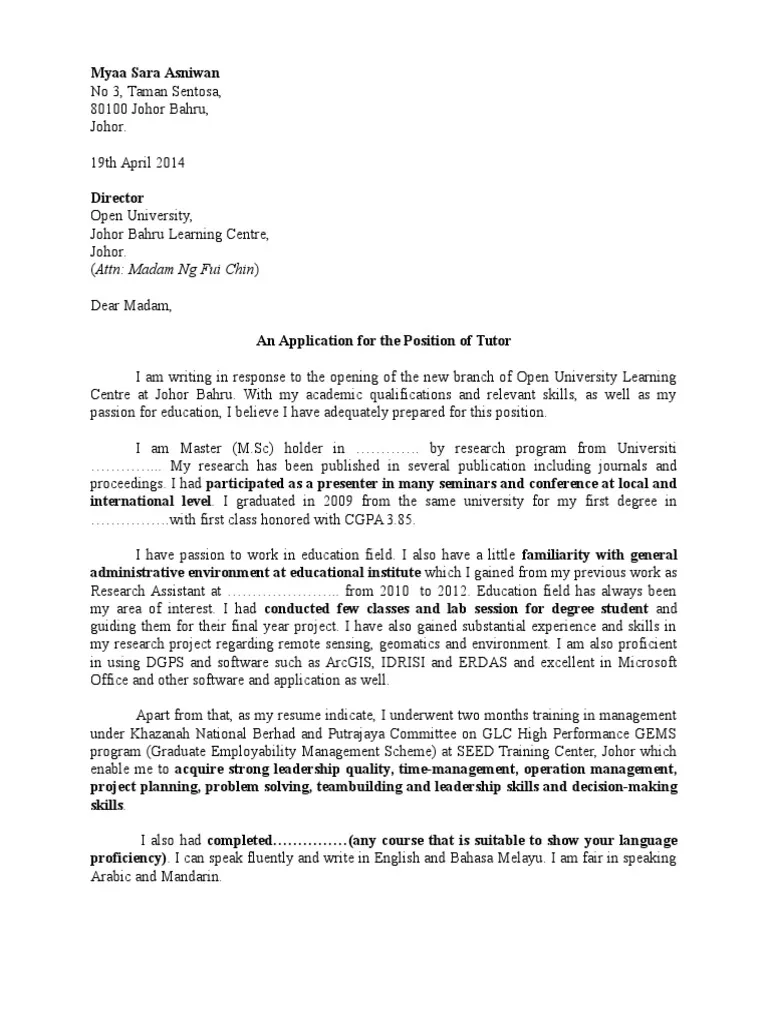Crafting a Tutor Job Cover Letter
A tutor job cover letter is your first opportunity to make a positive impression on a potential employer. It’s a crucial document that complements your resume, providing a more personalized and detailed account of your qualifications, experience, and enthusiasm for the tutoring position. A well-crafted cover letter can significantly increase your chances of landing an interview. It’s not just a formality; it’s a strategic tool to showcase why you are the ideal candidate for the role and demonstrate your understanding of the school’s or institution’s needs.
Understanding the Purpose of a Cover Letter
The primary purpose of a tutor job cover letter is to introduce yourself, highlight your relevant skills and experience, and express your interest in the specific tutoring position. It allows you to go beyond the bullet points of your resume and tell a story about your qualifications. It’s your chance to explain why you are passionate about tutoring, what motivates you, and how you can contribute to the students’ academic success. Moreover, a well-written cover letter demonstrates your communication skills, attention to detail, and your ability to follow instructions – all essential qualities for a tutor.
Highlighting Relevant Skills and Experience
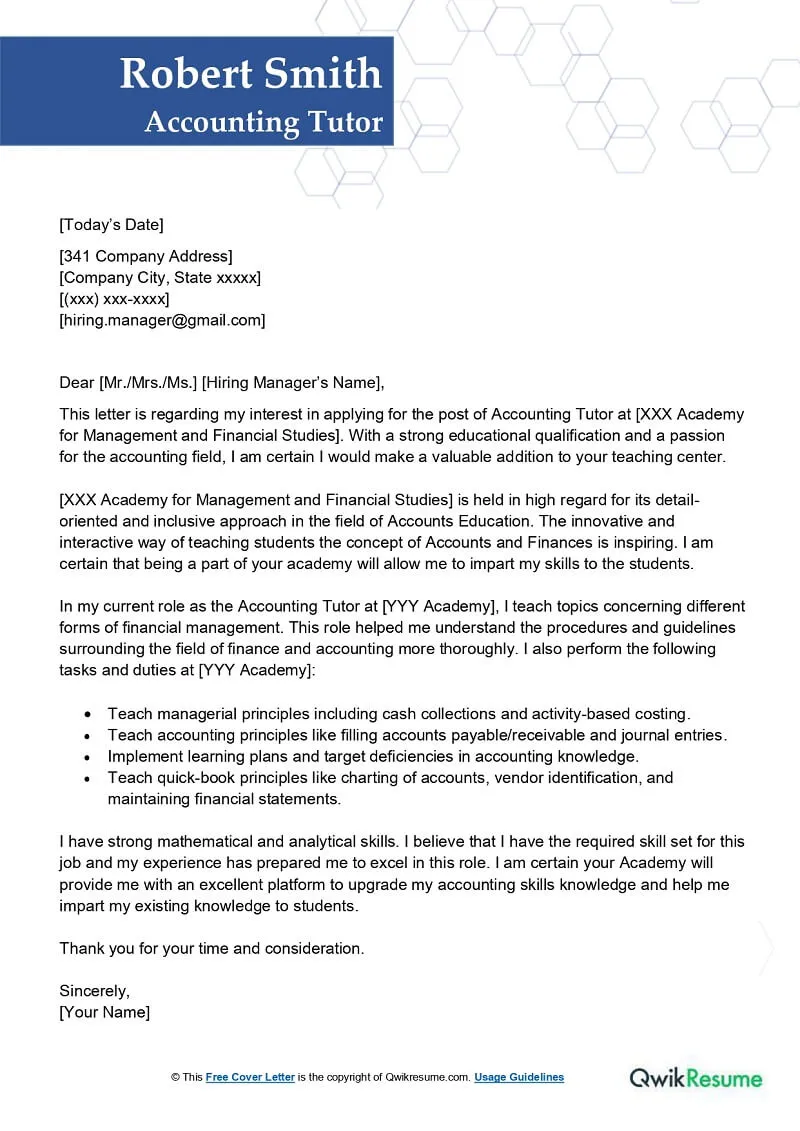
When writing your tutor job cover letter, it’s essential to focus on the skills and experience that directly relate to the tutoring position. Start by identifying the key requirements listed in the job description. Then, highlight your qualifications, such as your subject matter expertise, teaching experience, and any relevant certifications. Make sure to provide specific examples to illustrate your abilities. For instance, instead of simply stating “I am good at explaining complex concepts,” you can say “I have successfully helped students understand calculus by breaking down problems into simpler, manageable steps.” This approach makes your claims more credible and compelling.
Tailoring Your Cover Letter to the Job
Generic cover letters rarely impress hiring managers. Instead, take the time to tailor each letter to the specific tutoring job you’re applying for. This involves carefully reviewing the job description and understanding the school’s or institution’s needs and priorities. Identify the key skills and qualities they are looking for and adjust your letter accordingly. This shows that you have researched the opportunity and are genuinely interested in the position, rather than simply sending out mass applications. Mention the school’s name, its mission, or any specific programs that resonate with you. This level of personalization can significantly boost your application’s chances of success.
Researching the School or Institution
Before writing your cover letter, thoroughly research the school or institution. This research will help you understand their values, mission, and specific needs. Visit their website, read about their programs, and learn about their approach to education. This information will allow you to tailor your cover letter to align with their goals and demonstrate your understanding of their specific requirements. You can mention something specific about the institution that appeals to you, such as their commitment to student success or their innovative teaching methods. This shows that you have taken the initiative to learn about them and are genuinely interested in being part of their team.
Identifying Key Requirements

Carefully read the job description and identify the key requirements for the tutoring position. These may include specific subject matter expertise, experience with certain age groups or learning styles, and the ability to work effectively with students and parents. Make a list of these requirements and use it as a guide when writing your cover letter. Ensure that you address each requirement and provide evidence of how you meet them. For example, if the job description requires experience with elementary school students, highlight any tutoring experience or relevant volunteer work you have completed with this age group. This targeted approach shows that you are a good fit for the role.
Showcasing Your Qualifications
Your cover letter is the perfect opportunity to showcase your qualifications and demonstrate why you are the best candidate for the tutoring job. Provide specific examples to illustrate your skills and accomplishments. Instead of simply stating that you are a good communicator, describe a time when you successfully explained a complex concept to a student. If you have experience working with students with specific learning needs, mention it and explain how you adapted your teaching methods to meet their needs. Quantify your achievements whenever possible. For instance, mention the number of students you have tutored, the grade improvements they achieved, or any other relevant metrics that demonstrate your effectiveness.
Writing a Compelling Introduction
The introduction of your cover letter is crucial, as it sets the tone for the rest of the document. Start with a strong opening statement that grabs the reader’s attention. Clearly state the position you are applying for and where you found the job posting. Briefly mention your key qualifications and express your enthusiasm for the opportunity. Avoid generic phrases like “I am writing to express my interest.” Instead, try something more engaging, such as “I am writing to express my keen interest in the Tutor position at [School Name], as advertised on [Platform]. With my extensive experience in [Subject] and my passion for helping students succeed, I am confident that I can make a significant contribution to your team.”
Stating Your Enthusiasm for Tutoring
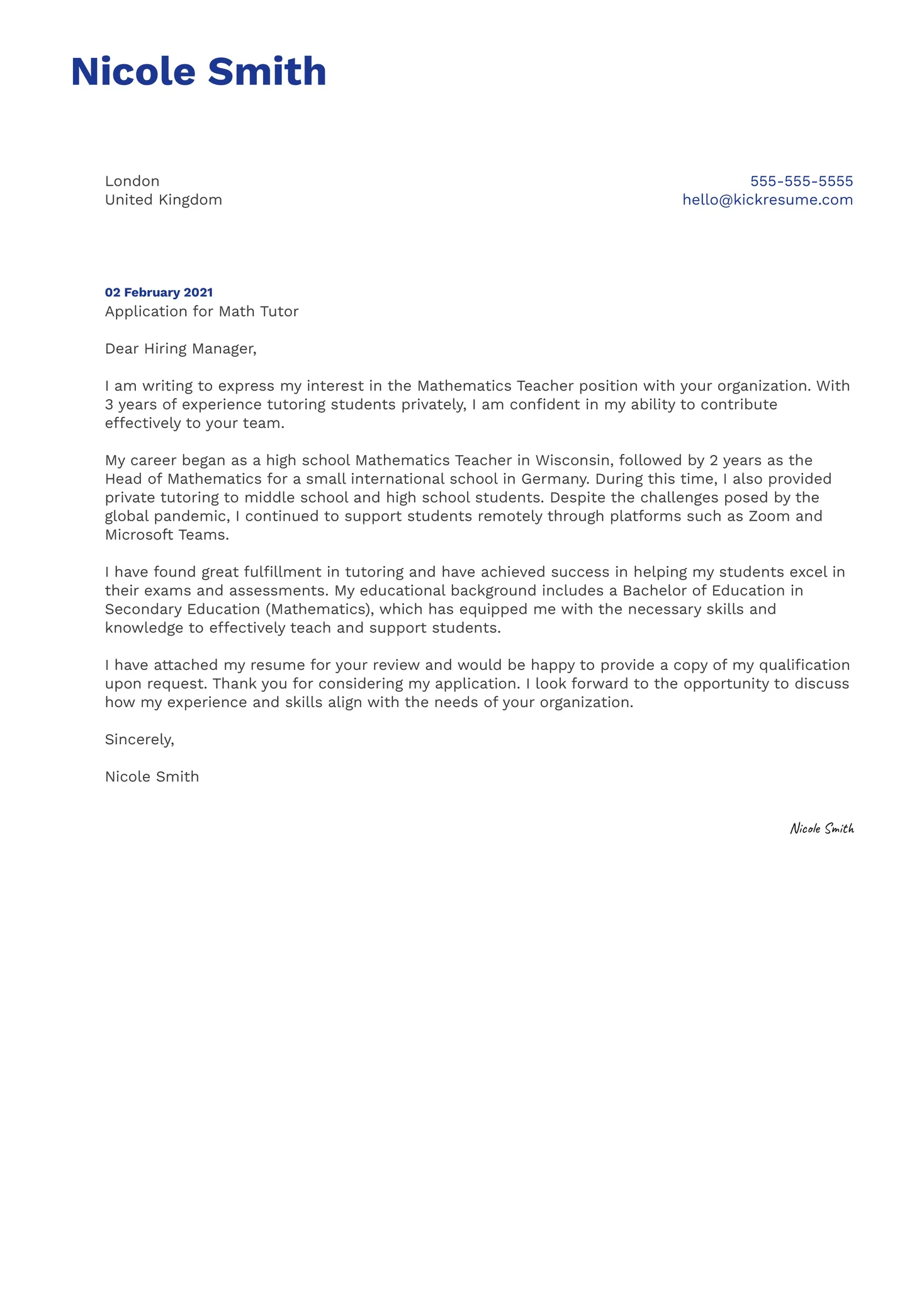
In your cover letter, clearly express your enthusiasm for tutoring. Explain what motivates you to work with students and why you enjoy teaching. Share your passion for the subject matter and your commitment to helping students achieve their academic goals. Show that you are not just looking for a job but are genuinely interested in making a positive impact on students’ lives. You can mention your personal experiences, such as your own positive experiences with tutors or your desire to help others learn and grow. This level of enthusiasm will make you stand out from other applicants.
Demonstrating Your Teaching Philosophy
Briefly describe your teaching philosophy in your cover letter. Explain your approach to tutoring and how you create a positive and effective learning environment. Do you emphasize building student confidence, tailoring lessons to individual needs, or promoting a love of learning? Share your beliefs about how students learn best and how you can contribute to their academic success. This demonstrates your understanding of teaching principles and shows that you have a clear vision for how you will approach your tutoring sessions. This also helps the employer assess if your teaching style aligns with their values and needs.
Structuring the Body of Your Cover Letter
Organize the body of your cover letter logically and clearly. Use paragraphs to separate different points and ideas. Start with a paragraph that highlights your relevant skills and experience. Then, discuss your teaching philosophy and your approach to tutoring. Provide specific examples of your past successes. If possible, include a paragraph that addresses the specific requirements of the job and how you meet them. Make sure to use headings and subheadings to organize your content and make it easier to read. Keep your language concise and easy to understand. Aim for a professional yet friendly tone to create a positive impression.
Describing Your Tutoring Experience
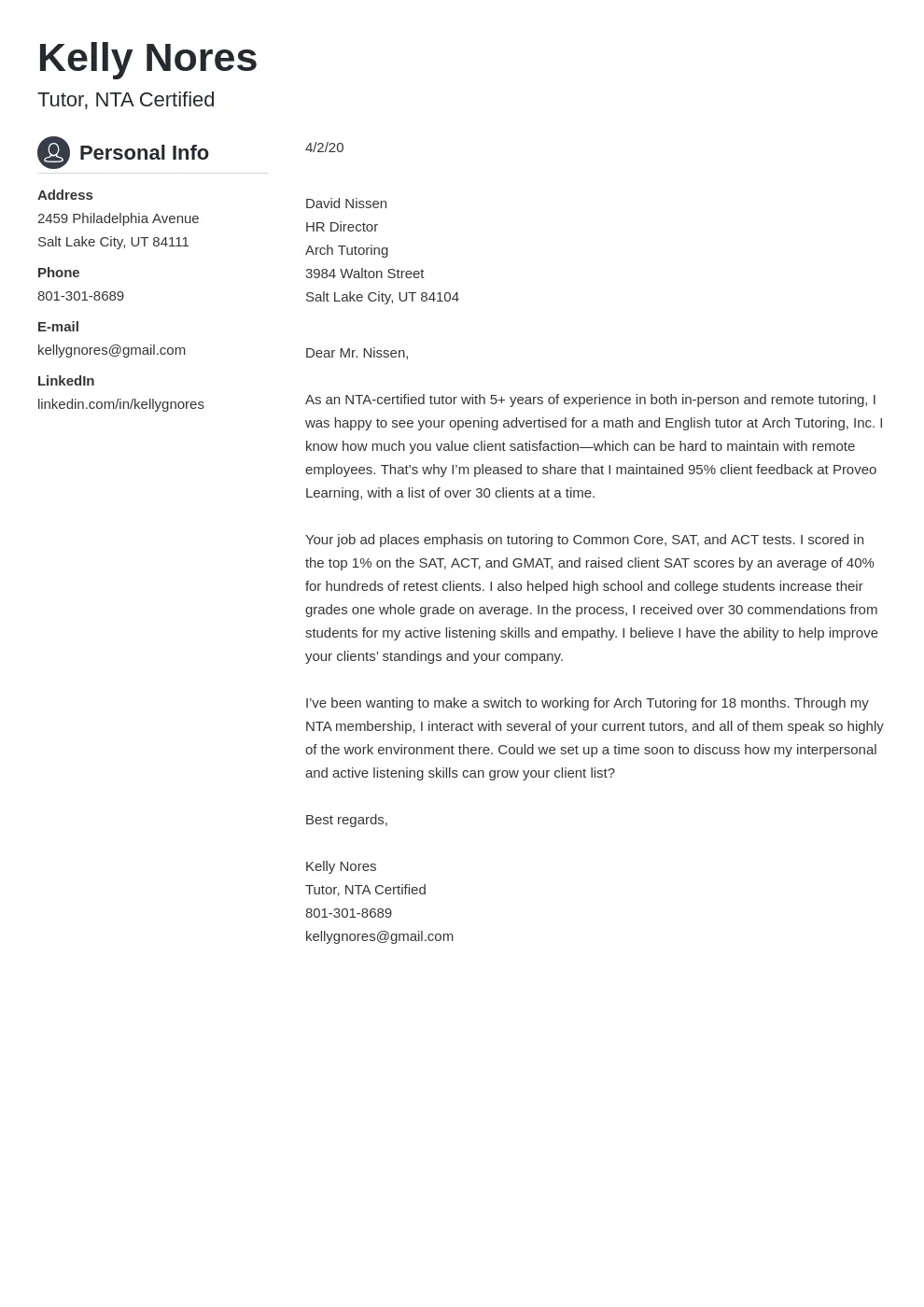
Provide detailed descriptions of your tutoring experience. Mention the subjects you have tutored, the age groups of the students you have worked with, and the types of tutoring environments you have experience in (e.g., one-on-one tutoring, group tutoring, online tutoring). For each experience, briefly explain your role and responsibilities. Highlight any specific teaching methods or strategies you have used. For example, you can mention your use of visual aids, hands-on activities, or differentiated instruction. The more detail you provide, the better the employer can understand your capabilities and the value you can bring to their tutoring program.
Quantifying Your Achievements
Whenever possible, quantify your achievements to make your cover letter more impactful. Instead of simply stating that you helped students improve their grades, provide specific metrics. For instance, “I helped my students increase their average test scores by 20%” or “I tutored over 10 students in [subject], with 80% achieving a grade improvement.” Quantifying your achievements demonstrates your effectiveness as a tutor and provides concrete evidence of your ability to produce results. Use data and numbers to illustrate your impact on student learning and make a stronger case for your candidacy. This approach will make your letter stand out and leave a lasting impression.
Providing Examples of Success
Back up your claims with concrete examples of your past successes. Describe specific situations where you helped students overcome challenges, achieve their goals, or improve their understanding of a subject. Mention any awards or recognition you have received for your teaching efforts. For example, you could describe a time when you helped a struggling student understand a difficult concept or when you prepared a student for a successful exam. The use of examples will help bring your experiences to life and demonstrate your ability to make a real difference in students’ lives. Moreover, it allows the employer to envision you succeeding in their tutoring program.
Focusing on Student Outcomes
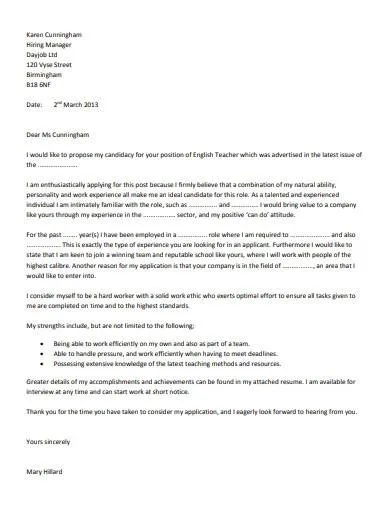
When describing your experience and achievements, focus on the outcomes you have helped students achieve. Show how you have helped students improve their grades, boost their confidence, and develop a love of learning. This highlights your ability to produce results and emphasizes your commitment to student success. You can mention specific examples of how you have helped students master difficult concepts, improve their study habits, and achieve their academic goals. Focus on the positive impact you have had on their lives and how you have contributed to their overall development. These outcomes will make your letter more compelling and attractive to prospective employers.
Addressing Specific Job Requirements
Ensure that your cover letter directly addresses the specific requirements listed in the job description. Highlight how your skills, experience, and qualifications align with those requirements. If the job description mentions a specific subject, age group, or tutoring method, make sure to provide evidence of your experience in those areas. Show that you have read the job description carefully and that you understand what the employer is looking for. By addressing specific requirements, you demonstrate that you are a good fit for the position and that you have the skills and experience needed to be successful. This tailored approach increases your chances of making a positive impression.
Matching Skills to the Job Description
Carefully match your skills and experience to the job description. Identify the key skills and qualifications the employer is seeking and tailor your cover letter to highlight those aspects of your background. For example, if the job description emphasizes the importance of communication skills, include examples of how you have effectively communicated with students, parents, and teachers in the past. Use the same keywords and phrases from the job description to show that you understand the role’s requirements and can speak their language. This attention to detail and strategic use of language will demonstrate that you are a good fit for the position.
Using Keywords Strategically
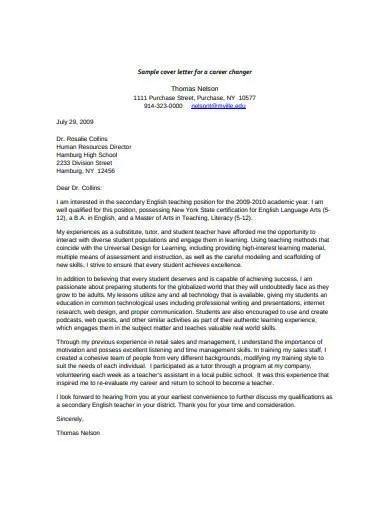
When writing your cover letter, use keywords strategically. Review the job description and identify the key terms and phrases used to describe the position and the required skills. Incorporate these keywords naturally into your cover letter to demonstrate that you possess the desired qualifications. This also helps the hiring manager quickly identify the relevant information and assess your suitability for the role. However, avoid keyword stuffing, which can make your letter sound unnatural and detract from your message. Use the keywords judiciously and in context to enhance the readability and impact of your cover letter.
Writing a Strong Conclusion
The conclusion of your cover letter is your final opportunity to leave a lasting impression. Summarize your key qualifications and reiterate your interest in the tutoring position. Clearly state that you are eager to learn more about the opportunity and are available for an interview. Thank the employer for their time and consideration, and provide your contact information. Make sure your conclusion is concise, enthusiastic, and leaves the reader with a positive impression of your candidacy. A strong conclusion will increase the likelihood of a positive response from the employer.
Reiterating Your Interest and Availability
In your conclusion, reiterate your interest in the tutoring position and express your eagerness to learn more about the opportunity. Emphasize that you are available for an interview at their earliest convenience. Make it easy for the employer to contact you by providing your phone number, email address, and any other relevant contact information. Avoid vague phrases like “I look forward to hearing from you.” Instead, try something more direct, such as “I am enthusiastic about the opportunity and available for an interview at your earliest convenience. You can reach me at [Phone Number] or [Email Address].” This conveys your enthusiasm and makes it easy for the employer to take the next step.
Expressing Gratitude

Always express gratitude to the employer for their time and consideration. A simple “Thank you for considering my application” or “I appreciate your time and consideration” shows respect and professionalism. This small gesture can leave a positive impression and demonstrate your appreciation for the opportunity. Avoid overly formal or generic phrases. Keep it concise and sincere, which will leave a better impression on the reader. Gratitude is a sign of respect, and it can often make the difference between your application and another candidate.
Proofreading and Editing
Before submitting your cover letter, proofread and edit it carefully. Errors in grammar, spelling, and punctuation can create a negative impression and undermine your credibility. Use a grammar checker and spell checker, but also read your letter aloud to catch any mistakes that those tools might miss. Ask a friend or family member to proofread your cover letter, as a fresh pair of eyes can often spot errors you might have missed. Thorough proofreading and editing are essential to ensure that your cover letter is professional, polished, and error-free. This demonstrates your attention to detail and your commitment to presenting yourself in the best possible light.
Checking for Grammatical Errors
Check your cover letter for grammatical errors. Pay close attention to sentence structure, verb tense, and subject-verb agreement. Ensure that your writing is clear, concise, and easy to understand. If you are unsure about a grammatical rule, consult a style guide or online resource. Poor grammar can make your cover letter difficult to read and can reflect poorly on your communication skills. It is important to project professionalism, and proper grammar shows your attention to detail.
Ensuring Clarity and Conciseness
Make sure your cover letter is clear and concise. Avoid using jargon or overly complex language that might confuse the reader. Keep your sentences short and to the point. Get rid of unnecessary words and phrases. Use strong verbs and active voice to make your writing more engaging. Your goal is to communicate your qualifications and enthusiasm in a way that is easy to understand. A clear and concise cover letter will make a more positive impression than one that is rambling or difficult to follow. It’s a sign of respect for the reader’s time and attention.
Formatting Your Cover Letter
Proper formatting is essential for creating a professional-looking cover letter. Use a standard business letter format, with your contact information at the top, the date, the employer’s contact information, and a formal salutation (e.g., “Dear Mr./Ms. [Last Name]” or, if you don’t know the name, “Dear Hiring Manager”). Keep the letter to one page in length. Use clear and readable fonts, and maintain consistent margins and spacing throughout the document. Formatting your cover letter correctly shows that you pay attention to detail and take pride in your work. An organized and professional document will make a strong impression on the employer.
Choosing a Professional Font
Choose a professional and readable font for your cover letter. Some common and acceptable fonts include Times New Roman, Arial, Calibri, and Helvetica. Avoid using overly stylized or decorative fonts, as they can be difficult to read and detract from your message. The font size should be between 10 and 12 points. Ensure that the font is consistent throughout the document and that it complements the overall tone of your cover letter. A professional font creates a positive impression and shows respect for the reader’s time and attention.
Organizing the Content Effectively
Organize the content of your cover letter effectively. Use paragraphs to separate different ideas and sections. Start with an introduction that grabs the reader’s attention and clearly states the position you are applying for. Then, in the body of the letter, highlight your relevant skills and experience and provide specific examples of your achievements. Conclude with a strong summary and reiterate your interest in the position. Use headings and subheadings to make your letter easier to read and to break up the text. A well-organized cover letter is easy to understand and allows the reader to quickly identify the key information about your qualifications and experience.
Formatting for Readability
Pay attention to the readability of your cover letter. Use clear and concise language, and avoid overly long sentences. Break up your text into paragraphs and use bullet points when listing skills or achievements. Use headings and subheadings to organize your content and guide the reader through your letter. Ensure that the margins are consistent and that there is adequate spacing between the lines and paragraphs. Use bold text to emphasize important information, but avoid overusing it. By formatting your cover letter for readability, you make it easier for the reader to quickly grasp the key information about your qualifications and experience. The more readable your letter is, the more effective it will be.
Submitting Your Cover Letter
Before submitting your cover letter, make sure you follow the application instructions carefully. If the job posting specifies how to submit your cover letter (e.g., through an online portal, as an email attachment), follow those instructions exactly. Make sure your cover letter is saved in the correct file format (e.g., PDF, Word document) as indicated. If submitting electronically, name the file appropriately (e.g., “[Your Name]_CoverLetter.pdf”). Proper submission demonstrates your attention to detail and your respect for the employer’s process. Failing to follow the instructions could make your application get rejected.
Following Application Instructions
Always carefully review and follow the application instructions provided in the job posting. These instructions may include specific requirements for formatting, submitting, and naming your cover letter and resume. Failure to follow these instructions can result in your application being rejected. Pay close attention to any deadlines and submit your application well in advance of the deadline. Demonstrate your attention to detail and your respect for the employer’s time. Following the application instructions is a key step in getting your application noticed and increasing your chances of landing an interview.
Sending a Professional Email
If you are submitting your cover letter and resume via email, ensure that the email is professional and well-formatted. Use a clear and concise subject line that includes the job title. Address the recipient appropriately (e.g., “Dear Mr./Ms. [Last Name]”). In the body of the email, briefly introduce yourself and mention that you have attached your cover letter and resume for review. Keep the email brief and to the point. Proofread your email carefully for any grammatical errors or typos. Sending a professional email demonstrates your attention to detail and helps make a positive first impression.
